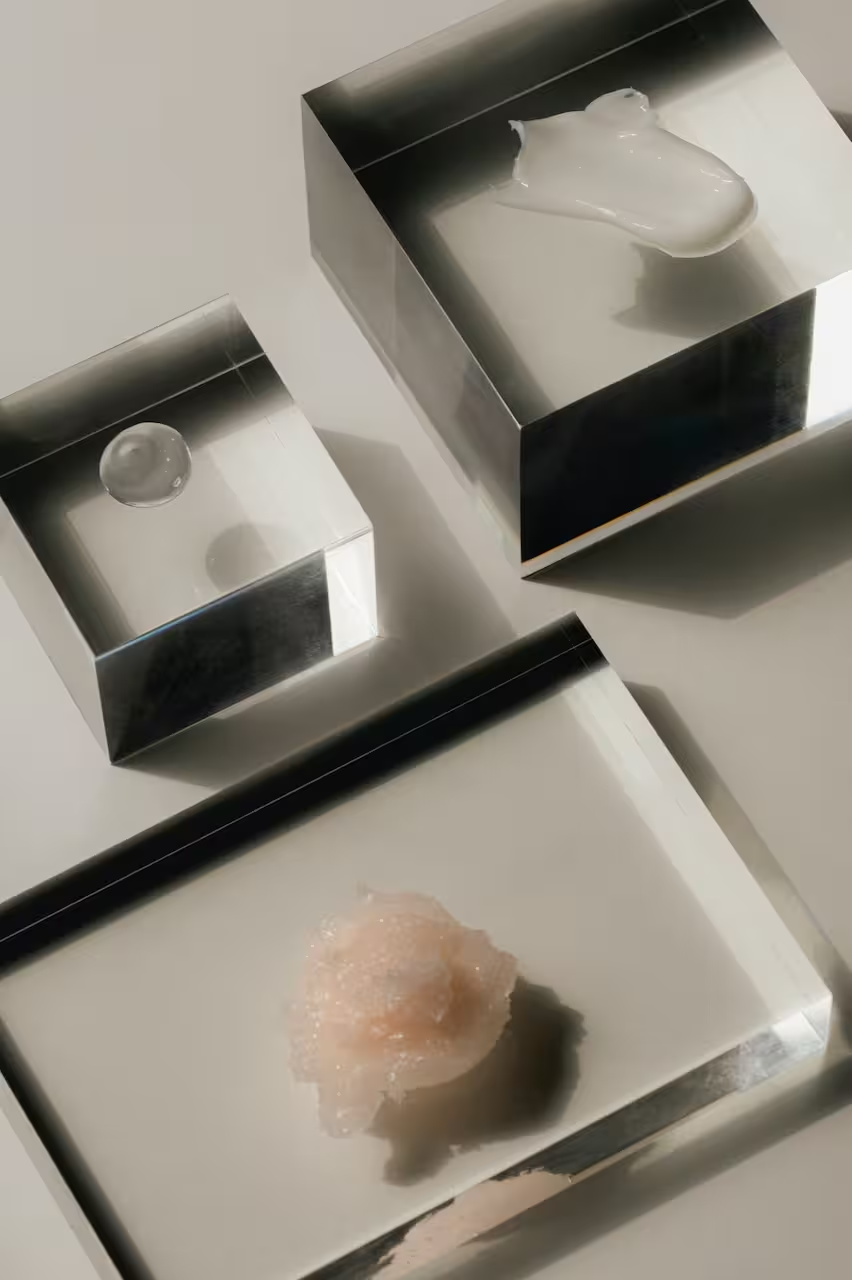

What Does a Yeast Infection Look Like?
Thick white clumpy discharge and itching are all signs of vaginal yeast infections. Learn what they look and smell like, and how Evvy’s test can help.
Words by Olivia Cassano
Scientifically edited by Dr. Krystal Thomas-White, PhD
Medically reviewed by Dr. Kate Stewart, MD
If you’ve noticed thick, white, clumpy discharge — often described as looking like cottage cheese — it might be your body’s way of signaling a vaginal yeast infection. This telltale symptom is one of the most common signs of a vaginal yeast infection, and typically shows up alongside itching, redness, irritation, or discomfort when you pee or have sex. But here’s the tricky part: not every itch or unusual discharge means it’s a vaginal yeast infection.
Research shows that most people who think they have a vaginal yeast infection are actually misdiagnosed. One study found that 77% of patients treated for yeast infections didn’t actually have one. That’s why being able to recognize the signs and knowing what a vaginal yeast infection looks and feels like is key to getting the right care.
Below, we’ll walk you through the visible symptoms of a vaginal yeast infection, how to tell it apart from other vaginal conditions, and how tools like vaginal microbiome testing and targeted probiotics from Evvy can help you take control of your vaginal health.
What is a yeast infection?
A vaginal yeast infection, also known as vaginal candidiasis, is a type of fungal infection caused by an overgrowth of the yeast Candida in the vaginal microbiome. Up to 90% of yeast infections are caused by a species of Candida called Candida albicans, but other strains can overgrow in the same way. These include Candida glabrata (C. glabrata), which is responsible for around 5% of cases, plus C. tropicalis, C. parapsilosis, and C. krusei, among others.
What does a yeast infection look like?
When it comes to physical signs, the symptoms of a yeast infection can be vague enough to overlap with other vaginal conditions, including bacterial vaginosis (BV), cytolytic vaginosis (CV), genital herpes, and certain vulvar conditions such as vulvar lichen sclerosus, vulvar lichen planus, and contact dermatitis.
A vaginal yeast infection can look like:
- Thick, vaginal discharge that is paste-like in consistency and looks like curdled milk or cottage cheese.
- A red, scaly rash that can spread beyond the vulva and onto the buttocks.
- A red, swollen vulva and vagina.
Yeast infections usually don’t cause wounds, ulcers, or bumps on the skin; however, it can be challenging to differentiate these symptoms if your yeast infection is causing a rash. In such cases, it’s best to reach out to a healthcare provider.
What does a yeast infection look like with pictures?
One of the most frustrating things about Googling vaginal symptoms is that it’s hard to produce an image of discharge or a description of an odor that encompasses everyone’s unique vaginal symptoms. Everything from the severity of an infection to lighting and underwear color can affect the way something like “yeast infection discharge” looks in a picture. The best way to figure out if you have a vaginal yeast infection is to actually test for it. However, yeast infection discharge is often compared to cottage cheese.
.jpeg)
What does a yeast infection feel like?
Unlike bacterial vaginosis, where up to 84% of people are asymptomatic, most people with a vaginal yeast infection know they have one because of the physical discomfort it causes. Common physical symptoms of a yeast infection may include:
- Vaginal and vulvar itching, redness, or soreness
- White vaginal discharge, that is curd-like in consistency
- Pain during sex
- Soreness or stinging when you pee, or during sex.
What does a yeast infection smell like? (And why it matters)
Yeast infections don’t usually cause vaginal odor. However, when there is a smell, it’s often described as mildly yeasty, similar to rising bread or beer. This bread-like scent is caused by the fermentation process triggered by yeast overgrowth. As Candida multiplies, it can produce compounds that smell similar to yeast or alcohol, which is why some people notice a faint, beer-like odor.
That said, it’s completely normal for a yeast infection to have no noticeable smell at all. If you notice a foul, rotten, or especially fishy odor, it’s more likely to be something else, such as BV, AV, trichomoniasis, or even a sexually transmitted infection like gonorrhea. BV, in particular, is known for its signature fishy smell, which tends to get stronger after sex.
If you’re experiencing recurrent yeast infections, it might be a sign that there’s an underlying imbalance in your vaginal microbiome. In that case, vaginal health testing and targeted probiotics, like those from Evvy, can help identify the root cause and support a healthier vaginal environment to reduce the risk of future infections.
What do I do if I think I have a yeast infection?
If you’re worried that you have a yeast infection, you’re not alone. Up to 75% of women will get a vaginal yeast infection in their lifetime.
Get a vaginal microbiome test
Before or after you’re done making your appointment, do yourself (and your vagina) a favor by ordering a vaginal microbiome test, like Evvy’s, so you know exactly what’s up down there while you’re having symptoms.
Like we mentioned above, many vaginal conditions have symptoms similar to a yeast infection (burning, itching, inflammation, discharge, and pain with sex and urination). For this reason, getting the right diagnosis is the first step in treating a yeast infection.
Unlike a PCR test, which only looks for the presence of select microbes, an Evvy test will tell you all of the types of bacteria and fungi in your vaginal microbiome, and their relative amounts. That means we test for Candida albicans, Candida glabrata, C. tropicalis, C. parapsilosis, and C. krusei, among others, with a single swab. Knowing this information can help you and your doctor make a plan for maintaining vaginal health that feels good for you and your body.

Recurrent symptoms? Get Evvy's at-home vaginal microbiome test, designed by leading OB-GYNs.
Get care for yeast infections with Evvy
If you’re experiencing yeast infection symptoms like itching, thick white discharge, or irritation, Evvy’s Vaginal Health Test can help you understand what’s really going on.
Our at-home vaginal microbiome tests uses advanced metagenomic sequencing to detect Candida, alongside a comprehensive view of your vaginal microbiome. After you receive your results, if Candida is identified, you may be eligible to order a personalized prescription treatment plan developed by a licensed healthcare provider, all through Evvy’s platform.
To support ongoing vaginal health, Evvy Women’s Complete Probiotic is formulated with clinically-studied Lactobacillus strains that help promote healthy bacteria and support yeast balance.
FAQs
How do you know if you have a yeast infection?
You might suspect a yeast infection if you experience symptoms like intense vaginal itching or irritation, a clumpy, white discharge that looks like cottage cheese, redness, and swelling of the vulva, and a burning feeling when pee or have sex. These symptoms are common indicators of a yeast infection, but they can overlap with other conditions, so it's important to consult a healthcare provider for a proper diagnosis or take an Evvy vaginal microbiome test.
How do I treat a yeast infection myself?
Yeast infections can be treated with over-the-counter antifungal medications readily available in drugstores and pharmacies. Even if you're just considering using an over-the-counter remedy, it's best to know what's going on down there. To make sure you get the most effective treatment for your yeast infection, both you and your healthcare provider need to understand what's happening in your vaginal microbiome. The specific type of Candida species causing the infection affects how well the treatment works. While you can buy yeast infection treatment over the counter, we'd recommend getting a vaginal microbiome test first!
Is a yeast infection an STI?
No, a yeast infection is not a sexually transmitted infection (STI). Sexual activity can trigger a yeast infection, but it’s possible to develop one even if you’re not sexually active.
What does yeast infection discharge look like on toilet paper?
Yeast infection discharge often appears white and clumpy, a bit like cottage cheese. When you wipe, it may show up on toilet paper as small, lumpy white patches or globs. It typically doesn’t spread like typical vaginal fluid and can appear somewhat paste-like or curdled rather than smooth or slippery. This discharge is usually odorless and doesn’t soak into the toilet paper as much as more watery types of discharge. You might also notice it accompanied by redness or irritation around the vulva. If your discharge is thin, grayish, yellow-green, or has a strong fishy or foul odor, it’s more likely to be something other than a yeast infection, such as BV or trichomoniasis, so it’s important to get tested to know for sure.
Can you have a yeast infection without smell?
Yes, you can absolutely have a yeast infection without any noticeable smell. Most vaginal yeast infections are odorless. Unlike BV, which is often associated with a strong, fishy odor, yeast infections have a strong scent. When there is a smell, it may be faintly yeasty or bread-like due to fermentation, but many people with yeast infections notice no odor at all. If you're experiencing symptoms like thick, white, clumpy discharge, vaginal itching or burning, redness or swelling of the vulva, or discomfort when you pee or have sex — but no smell — it could still very well be a yeast infection. That said, because these symptoms can overlap with other conditions, it's a good idea to confirm the cause, especially if it’s your first time experiencing them or if they keep coming back. Evvy’s Vaginal Health Test can help identify whether Candida or another microbe is responsible, so you can get the right treatment.
Does a yeast infection always have white discharge?
No, a yeast infection doesn’t always have white discharge. While white, clumpy discharge is one of the most recognizable symptoms of a vaginal yeast infection, it’s not present in every case. Some people experience other symptoms, like intense itching, burning, redness, or irritation, without any noticeable discharge at all. In other cases, the discharge might be thinner, more watery, or simply minimal, making it harder to identify based on appearance alone. That’s why it’s important not to rely on discharge alone when trying to determine if you have a yeast infection. If you’re unsure, taking an Evvy’s Vaginal Health Test can help you confirm whether Candida is the cause of your symptoms, or if another vaginal infection may be to blame.





